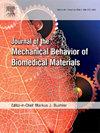肌肉包装对兔跖跗关节三维结构的影响
IF 3.3
2区 医学
Q2 ENGINEERING, BIOMEDICAL
Journal of the Mechanical Behavior of Biomedical Materials
Pub Date : 2024-09-29
DOI:10.1016/j.jmbbm.2024.106762
引用次数: 0
摘要
在生理状态下,肌肉周围有结缔组织、其他肌肉和骨骼。这些组织产生的横向力会改变肌肉的三维形状,而在孤立状态下,周围的组织都会被移除。形状的改变会影响肌肉的结构,从而影响其机械特性。兔跖腓肠肌是一种多瓣小腿肌肉,由两部分组成。一个较小的双瓣内肌区嵌入一个较大的单瓣外肌区中(Böl 等人,2015 年)。作为小腿的一部分,足底肌紧紧包裹在其他肌肉之间。目前还不清楚包装如何影响足底肌的形状和结构。因此,我们研究了三只兔子对侧腿的孤立足底肌和包装足底肌,分别使用摄影测量重建和手动数字化确定周围肌肉对其形状和结构特性的影响。与孤立状态相比,在包裹状态下,足底筋膜笔直度增加了 27%,筋膜弯曲度增加了 54%。束带长度不受肌肉包装的影响。肌肉结构的变化主要发生在足底外侧。此外,孤立的足底肌显示出更圆的形状,其肌腹的宽度也有所减少。由此可以得出结论,包装后的足底肌肉在周围肌肉的作用下变得扁平,从而导致复杂的结构变化。所提供的数据增进了我们对一般肌肉包的了解,可用于开发和验证逼真的三维肌肉模型。本文章由计算机程序翻译,如有差异,请以英文原文为准。
Influence of muscle packing on the three-dimensional architecture of rabbit M. plantaris
In their physiological condition, muscles are surrounded by connective tissue, other muscles and bone. These tissues exert transverse forces that change the three-dimensional shape of the muscle compared to its isolated condition, in which all surrounding tissues are removed. A change in shape affects the architecture of a muscle and therefore its mechanical properties. The rabbit M. plantaris is a multi-pennate calf muscle consisting of two compartments. A smaller, bi-pennate inner muscle compartment is embedded in a larger, uni-pennate outer compartment (Böl et al., 2015). As part of the calf, the plantaris is tightly packed between other muscles. It is unclear how packing affects the shape and architecture of the plantaris. Therefore, we examined the isolated and packed plantaris of the contralateral legs of three rabbits to determine the influence of the surrounding muscles on its shape and architectural properties using photogrammetric reconstruction and manual digitization, respectively. In the packed condition, the plantaris showed a 27% increase in fascicle pennation and a 54% increase in fascicle curvature compared to the isolated condition. Fascicle length was not affected by muscle packing. The change in muscle architecture occurred mainly in the outer compartment of the plantaris. Furthermore, the isolated plantaris showed a more circular shape and a reduced width of its muscle belly. It can be concluded that the packed plantaris is flattened by the forces exerted by the surrounding muscles, causing a complex architectural change. The data provided improve our understanding of muscle packages in general and can be used to develop and validate realistic three-dimensional muscle models.
求助全文
通过发布文献求助,成功后即可免费获取论文全文。
去求助
来源期刊

Journal of the Mechanical Behavior of Biomedical Materials
工程技术-材料科学:生物材料
CiteScore
7.20
自引率
7.70%
发文量
505
审稿时长
46 days
期刊介绍:
The Journal of the Mechanical Behavior of Biomedical Materials is concerned with the mechanical deformation, damage and failure under applied forces, of biological material (at the tissue, cellular and molecular levels) and of biomaterials, i.e. those materials which are designed to mimic or replace biological materials.
The primary focus of the journal is the synthesis of materials science, biology, and medical and dental science. Reports of fundamental scientific investigations are welcome, as are articles concerned with the practical application of materials in medical devices. Both experimental and theoretical work is of interest; theoretical papers will normally include comparison of predictions with experimental data, though we recognize that this may not always be appropriate. The journal also publishes technical notes concerned with emerging experimental or theoretical techniques, letters to the editor and, by invitation, review articles and papers describing existing techniques for the benefit of an interdisciplinary readership.
 求助内容:
求助内容: 应助结果提醒方式:
应助结果提醒方式:


